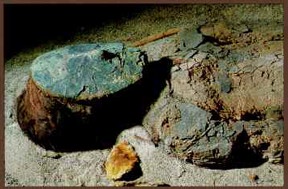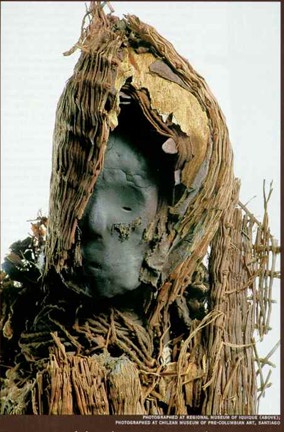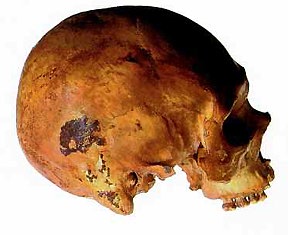Chile's Ancient Mummies
More than 7,000 years ago,
hunter-gatherers used elaborate techniques to preserve their dead
by Marvin Allison
(All of the pictures have been taken
from National Geographic Magazine, March 1995, pages 69-81; the text is
taken Natural History Magazine, October 1985.)
Arica, Chile's northernmost port, thrives in
defiance of the arid lands that surround it. The lifeline for the city and
its more than 100,000 inhabitants is the San Juan River, a tiny line of
fresh, sweet water that threads its way out of the Andean foothills and
across some seventy-five miles of the world's driest descent to the
Pacific Ocean.
A tall promontory, El Morro, looms above the
southern edge of the city. Late in 1983, a ditch- digging machine was
cutting a trench for a new waterline on El Morro's lower slopes when its
blades began to churn up the legs and broken bodies of men, women, and
children. The pipeline project had intruded into a pre-Columbian
graveyard. In time, teams of archeologists and students uncovered
the remains of 96 individuals, a most valuable addition to the growing
collection of more than 1,500 mummies at the university's Museum of
Archeology.
With ever improving techniques of analysis and
dating, these mummies, along with smaller collections at other
institutions in Chile, are providing unprecedented insights into the early
history of human disease, nutrition, and culture, including a practice of
mummification more complex than the Egyptian process, even though it is
two to three thousand years older. Our oldest specimens are, by far, the
oldest-known mummies in the world.
Mummification can occur naturally, with the right
environmental conditions, or artificially, when humans take steps to
preserve a corpse. The conditions in northern Chile are excellent for
natural mummification. Because the cold Humboldt current upwells off the
coast, the warmer air collects little moisture from the Pacific Ocean.
Thus, from the coast to the foothills of the Andes, it almost never rains.
Years pass without rain, and in those rare years when some rain does fall,
it is not heavy enough to penetrate a foot or more of soil. The absence of
moisture, not just for years or centuries but for millennia is the main
reason for this unsurpassed collection of mummies.
Bodies discovered in an unmarked colonial
graveyard about ten miles east of Arica at the Church of San Miguel
illustrate the importance of aridity. The small church is next to an
ancient Indian burial site where people have been interred mostly  without
anificial mummificationfor nearly 3,000 years. The corpses of the ancient
Indians are dehydrated, but their bones are still firmly attached, their
skin and hair still present. In contrast, the remains of the colonials,
buried in front of the church, were mostly nothing but bones. We were
puzzled by this difference until we discovered that attendants always
sprinkled irrigation water around the church to keep down the dust.
Moisture, penetrating the soil and the graves, had caused the corpses to
deteriorate. without
anificial mummificationfor nearly 3,000 years. The corpses of the ancient
Indians are dehydrated, but their bones are still firmly attached, their
skin and hair still present. In contrast, the remains of the colonials,
buried in front of the church, were mostly nothing but bones. We were
puzzled by this difference until we discovered that attendants always
sprinkled irrigation water around the church to keep down the dust.
Moisture, penetrating the soil and the graves, had caused the corpses to
deteriorate.
The burial practices of the ancient Indians
probably helped preserve the corpses. Bodies were usually placed in
shallow holes in seated, huddled positions, and then covered with cloth
and reed mats. Under the strong sun, these grave sites were, in effect,
solar ovens in which the corpse quickly dried out. In time, windblown sand
drifted over the grave, further preserving the cadaver. And finally, the
large amounts of salts, including nitrates, in the soil acted as natural
preservatives.
In 1919, Max Uhle, the first archeologist to
study these mummies, assumed that the natural mummies he found were the
oldest and most primitive, while the elaborately prepared anificial
mummies were more recent. Without the benefits of modern dating methods,
he estimated the primitive mummies were about 2,000 years old. Uhle named
these people the Chinchorro, or gill netters, recognizing their maritime
location and fishing practices. We still use Uhle's name for these early
Americans, as well as his classifications for mummy types, but carbon 14
dating has revealed two surprises.
First, the oldest Chinchorro are four times older
than Uhle's estimate. Our oldest mummy has been dated at 7,810 years B.P.
(before the present), plus or minus 180 years. Hans Niemeyer, who has
excavated Chinchorro sites in the Camarones Valley sixty-five miles south
of Arica, has obtained carbon dates of 7,420 B.P. and 7,000 B.P. With a
series of carbon 14 dates, using material from the mummies, we now
estimate the Chinchorro culture extended roughly from 7,800 to 3,800 B.P.
The Chinchorro were probably closely related to another preceramic culture
of the area, the Quiani (3,400 to 3,200 B.P.), and to the Faldas de Morro,
a group with the first ceramics and metals in the area (2,800 B.P.). In
short, in one small area we have found human and cultural remains that
span a 5,000-year period. And some preliminary genetic and anthropometric
studies indicate that all these people were closely related.
The second surprise from the dating was that the
7,800-year-old body, a man of about thirty- five years, was not a natural
mummy but was instead an example of one of the most complex forms of
mummification. This discovery raises all sorts of questions: Are there
older mummies yet to be found? Where did the idea and the skills of
mummification come from? How long have humans with complex cultures been
in the Americas? These questions, and others, lead to interesting
speculations; but since I am a paleopathologist, I spend my time studying
the bodies and the artifacts found with them. The data they contain are
fascinating enough for me.
The ninety-six bodies from El Morro, as indicated
by carbon 14 dates, were interred over a period of more than 3,000 years.
They represent all types of mummification, from simple air drying to the
elaborate classic style. While there are many variations, all thirty-five
classic mummies
show the Chinchorro had techniques and a knowledge of anatomy that
contradict any notion that they were primitive, even though they had
neither metal nor ceramics.
The first step for a classic mummification
involved a careful incision in the cadaver and the removal of the internal
organs, which deteriorate quickly. The skin and hair were cut away from
the corpse, and major muscles were removed. The brain was removed through
an opening cut in the skull or by hooking it out through the foremen
magnum (the opening at the base of the skull). All this was done without
metal knives. The embalmers used sharpened stones and shells and the
sharpened beaks of pelicans. We have found a number of these beaks in
grave sites. After 5,000 years they are still sharp, strong, and effective
tools.
The body was quickly dried by filling it with hot
coals and ashes. The skin and hair probably were soaked in salt water.
Then the mummy makers - who were most likely specialists in the tribe -
took a number of steps to make the corpse rigid. They rubbed the elbow and
knee joints with abrasive stones until the bones were flat and then bound
them together with fiber ropes. Another fiber rope ran down the arms and
across the chest at the level of the collarbones to prevent the chest
cavity from flopping open. They drove a sharpened stick under the flesh
along the spinal column and tied the vertebrae to this stake. Two other
sticks were inserted from each ankle to the skull.
When the body was rigid and dry, the mummy makers
wrapped reed matting along the legs and arms, and across the shoulders.
They filled the body cavity with wool, feathers, grass, shells, and earth.
After binding the halves of the skull together with fiber cord, they
wedged it on the ends of wooden poles at the neck and over the rope- bound
vertebrae. To give the mummy a lifelike shape, the Indians molded clay
over the limbs. Since the kneecaps had been discarded, the skin at the
knees was cut and sewed tight.
The mummy makers sculpted a face mask of clay,
with holes for the eyes and mouth. They tied the corpse's hair in bunches
and bound it to the mask with rope. They painted the mummy black during
some periods, red during others.
There were many minor variations from this
procedure. Children were often simply eviscerated through an incision in
the abdomen and filled with ashes and hot coals. Poles were tied to the
legs or slipped under the skin. In other cases, skin on children was cut
in strips and wrapped around their bodies like a bandage. With some
mummies, the skins of other animals - often pelicans or sea lions - were
used to cover the bodies. In all cases, the idea was to make the body
rigid and rebuild it to lifelike dimensions.
When the mummy was finished, it was not buried. Apparently as some form
of ancestor worship, mummies were propped up in groups and continued to
inhabit the community; perhaps in a spiritual sense they helped to bring
good hunting and fishing to their descendants. In return, the living kept
the dead in good condition, as indicated by the repairs on many mummies.
Eventually, possibly when certain influential people died, the older
mummies were buried in small groups. Since many burial groups contained
adults and children, perhaps
the deceased were interred as a family.
We also found many plant and animal remains at
the grave sites. These materials, along with the mummies and even the
campsite dirt stuffed into the mummies, have provided us with many clues
about the daily lives of the Chinchorro. The early Indians were hunters
and gatherers, living mainly on products from the sea. They used
sophisticated gill
nets to catch fish off the beaches (a method
still used by some Indians in the area today). They hunted sea birds and
marine mammals, particularly the sea lion, which they speared with a barbed
harpoon.
The Chinchorro did not practice agriculture, with
the possible exception of growing reeds for mats and fiber. They used the
products of their environment pelican beaks and feathers, seashells, sea
lion hides, and even whalebone for practically all their needs. We have
found some use of feathers and llama wool, which would indicate the
coastal Chinchorro traded with the inhabitants of the Andean highlands.
The Chinchorro men suffered from one of the
earliest known occupational diseases; one-quarter of them had a bony
growth in the ear canal - probably the result of  multiple
ear infections - that would have led to deafness. Such growths are common
in people who dive persistently for shellfish.
Since none of the women had this lesion, they apparently did not go shell
fishing. The women did, however, have "squatting facets" at the
ankle-shinbone joint. These lesions occur when people work in a squatting
position - in this case, probably opening shellfish. Nearly half the women
had an arthritic degeneration of the neck vertebrae, probably from
carrying heavy loads. multiple
ear infections - that would have led to deafness. Such growths are common
in people who dive persistently for shellfish.
Since none of the women had this lesion, they apparently did not go shell
fishing. The women did, however, have "squatting facets" at the
ankle-shinbone joint. These lesions occur when people work in a squatting
position - in this case, probably opening shellfish. Nearly half the women
had an arthritic degeneration of the neck vertebrae, probably from
carrying heavy loads.
This division of labor, as well as the complex
processes of mummification, means that individuals among the Chinchorro
had specialized jobs and clear roles according to sex. This is unusual for
such an early, small, and isolated group of humans. In later cultures, the
practice of mummification degenerated, and judging from the hunting and
fishing gear webbing buried with both women and men, the roles of the
sexes merged.
 Because
of my interest in pathology, I usually focus on diseases and causes of
death, but I do not want to give the impression that the Chinchorro were
sickly. They appeared to eat a relatively
high-protein diet and to lead active, healthy lives. Because
of my interest in pathology, I usually focus on diseases and causes of
death, but I do not want to give the impression that the Chinchorro were
sickly. They appeared to eat a relatively
high-protein diet and to lead active, healthy lives.
As one of my younger associates noted, holding up
a skull of a middle-aged man, the mummy's teeth were in much better
condition than his own. In later cultures, when irrigation agriculture
came to the valley, Indians ate more carbohydrates and less protein. And
the teeth of these later Indians have many more cavities. Unlike the
Chinchorro, their successors knew the agony of a toothache.
For perhaps 15,000 years, if not longer, the
western coast of South America for hundreds of miles north and south of
Arica has been dominated by inhospitable desert. Only a few isolated
groups of Indians, clustered around rare sources of fresh water, managed
to eke out a living. In their narrow niche, these Indians lived
differently and apart from the major groups and Indian civilizations of
the Andean highlands and the continental interior. Some preliminary
genetic surveys indicate these Indians were the direct descendants of
earlier tribes that lived in the region for many thousands of years. Such
continuity is without precedent anywhere else in the world.
And the arid conditions that so shaped their
lives also preserved them in death. As our techniques of analysis improve,
we will learn more about the daily lives and conditions of these obscure
Indians than we know about any other group in prehistory. After nearly
8,000 years of silence, the Chinchorro are beginning to tell their story,
and we have much to learn about them - and ourselves.
www.mc.maricopa.edu/.
../legacy/chincho/ |
